
John Shepherd once said that counting fish is like counting trees, except that fish move and you can’t see them because they’re underwater. This is true with sharks as well. It’s basically impossible to know how many sharks there are. Fortunately, a variety of methods exist that can be used to determine population trends. In other words, even if we can’t know how many sharks there are, we can tell if there are more or less than there used to be. Presented here are brief descriptions of some of these methods and the conclusions of major shark conservation studies that used them. Though no one method is perfect, the fact that so many different methods have such similar conclusions is quite telling.
Fisheries-dependent population surveys
Many commercial fisheries are legally required to keep extremely detailed records of their catch (and bycatch), and some of these records are publicly available. Population studies that utilize the records of commercial fisheries are referred to as “fisheries dependent”. There are many, many more fishing boats than scientific research vessels, which results in much more data. All other variables being equal, if fishing boats catch fewer sharks per trip, it means that fewer sharks are there.
The most famous example of a fisheries-dependent population survey of sharks came from Dr. Julia Baum. She and her team analyzed fisheries data from the United States open-ocean longline fleet, which focuses on swordfish and tuna but often catches sharks. In between 1986 and 2000, over 200,000 longlines were set in the Northwest Atlantic Ocean. Fishing vessels recorded the number of sharks of various species caught during each longline deployment, and Dr. Baum calculated the trends in shark catch over time from these data.
Her results were startling, and the resulting research paper (Collapse and Conservation of Shark Populations in the Northwest Atlantic) has been cited over 500 times. Since 1986, Dr. Baum’s analysis of logbook data suggests a population decline of 89% in hammerhead sharks, 79% in great white sharks, 65% in tiger sharks, 80% in thresher sharks, 60% in blue sharks, and 70% in mako sharks.
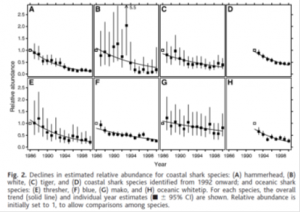
In a similar paper focusing on longline fishing in the Gulf of Mexico, Dr. Baum found other alarming trends. In the 1950’s, sharks were about 17% of the total catch on longlines (approximately 7 sharks caught per 1,000 hooks set). In the 1990’s, sharks were only 2% of the total longline catch (approximately 1 shark per 1,000 hooks). Oceanic whitetip sharks, which were once considered the most abundant large predator on Earth, were caught in 64% of longline sets in the 1950’s and were almost never caught in the 1990’s. This indicates that the population of oceanic whitetip sharks declined by more than 99% since the 1950’s.
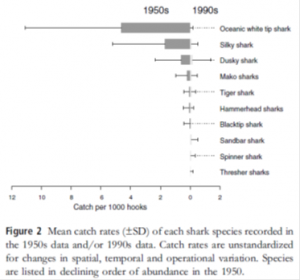
Many fisheries scientists have concerns about using fishery-dependent data. Though fishery-dependent datasets are generally much larger, the data that is collected is not the focus of the voyage- it is incidental to the fishing. Numerous questions have been raised about how accurate this kind of data is, since some fishermen may inaccurately report their catch intentionally to avoid fines for catching too much of the wrong species, while others may simply be unable to accurately identify the difference between closely related species. In fact, a great deal of fishery-dependent data simple says “shark” without even attempting to identify the species in question.
Additionally, it is important to note that fisheries-dependent studies like Dr. Baum’s do not necessarily show that there are 65% fewer tiger sharks in the Northwest Atlantic- the data show that fishermen reported catching 65% fewer tiger sharks in the Northwest Atlantic. Some of the decline might be due to changes in how catches are reported. Some of the decline might be due to the fishing fleet changing gear that results in catching less bycatch (including sharks). With reported declines this severe, however, it seems likely that actual population declines are a major piece of the puzzle.
Fishery independent surveys
An alternative method to tracking the population of marine animals is known as fisheries-independent surveys. With these surveys, a research vessel attempts to catch fish specifically to assess their populations. Trained experts record the catch, eliminating observer bias. These surveys typically use the same gear and visit the same sites year after year specifically to avoid the biases described in the last paragraph. These surveys are typically run by universities or governments (state or Federal).
Many fisheries independent surveys found similar results as the studies described above. A 2007 paper called “Cascading effects of the loss of apex predatory sharks from a coastal ocean” used data from a fishery-independent survey in North Carolina state waters that has been ongoing since 1972. All of the large sharks in the survey have decreased in population in the last 35 years, some by more than 90%.

Beach nets
Several resort communities in Australia and South Africa place “shark nets” along their beaches. While these are environmentally damaging and do very little to protect people from shark attacks, they do provide a useful method for indirectly tracking shark populations over time. (Feretti 2010, Holden 1977). The nets are set up in approximately the same area year after year, and net technology hasn’t really changed very much lately.
Francesco Feretti analyzed catch data from beach netting programs, and found that during the brief period from 1952 to 1972, catch rates for shark species in South Africa declined between 27% and 99%. Additionally, since the 1960’s, Australian shark nets have decreased their total catch by about 85%. The net programs themselves aren’t the cause of this decline (there aren’t enough nets to do this kind of ecological damage), but they show that declines have occurred pretty convincingly.
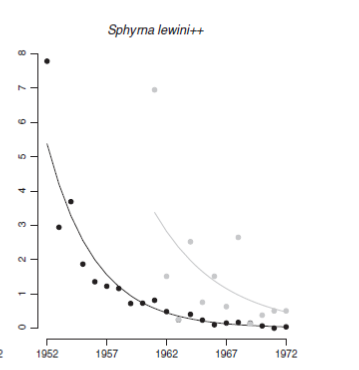
Diver surveys
One of the groups most likely to encounter sharks is the recreational SCUBA diving community. Many SCUBA divers take part in “visual census” surveys, reporting what they see on a dive to scientists. These databases are treasure troves for scientists, particularly those studying fish populations in the Caribbean.
Shark researcher Christine Ward-Paige analyzed over 75,000 dives worth of survey data from throughout the Caribbean Sea, and found that divers were much more likely to see sharks in isolated areas away from large groups of humans, or in areas which have enacted shark conservation policies. Sharks were rarely, if ever, seen on dives near large concentrations of humans and the associated fishing fleets.
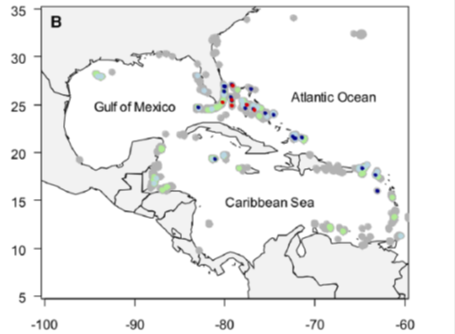
Observing pristine systems
Another way to measure how severe shark population declines are is to observe the natural abundance of sharks in pristine, unfished ecosystems. Unfortunately, as fishing boats get more and more high-tech, there are precious few of these pristine ecosystems left.
However, a recent expedition to the relatively-pristine Northern Line Islands made a shocking discovery. In unexploited reef systems, there are a LOT of sharks, which the authors refer to as an “inverted trophic pyramid” ! Additionally, the relative number of sharks changes proportionally with fishing pressure.
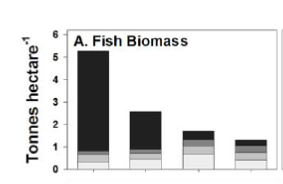
Conclusions
We may never know exactly how many sharks are out there, or exactly how many are killed each year. What we do know, from a variety of different types of analysis, is that many species of sharks are decreasing in population at alarming rates. Perhaps more importantly, we know why so many sharks are being killed, and we know how to stop it.
Baum JK, Myers RA, Kehler DG, Worm B, Harley SJ, & Doherty PA (2003). Collapse and conservation of shark populations in the Northwest Atlantic. Science (New York, N.Y.), 299 (5605), 389-92 PMID: 12532016
Baum, J., & Myers, R. (2004). Shifting baselines and the decline of pelagic sharks in the Gulf of Mexico Ecology Letters, 7 (2), 135-145 DOI: 10.1111/j.1461-0248.2003.00564.x
Burgess, G., Beerkircher, L., Cailliet, G., Carlson, J., Cortés, E., Goldman, K., Grubbs, R., Musick, J., Musyl, M., & Simpfendorfer, C. (2005). Is the collapse of shark populations in the Northwest Atlantic Ocean and Gulf of Mexico real? Fisheries, 30 (10), 19-26 DOI: 10.1577/1548-8446(2005)30[19:ITCOSP]2.0.CO;2
Ferretti, F., Worm, B., Britten, G., Heithaus, M., & Lotze, H. (2010). Patterns and ecosystem consequences of shark declines in the ocean Ecology Letters DOI: 10.1111/j.1461-0248.2010.01489.x
Myers, R., Baum, J., Shepherd, T., Powers, S., & Peterson, C. (2007). Cascading Effects of the Loss of Apex Predatory Sharks from a Coastal Ocean Science, 315 (5820), 1846-1850 DOI: 10.1126/science.1138657
Sandin SA, Smith JE, Demartini EE, Dinsdale EA, Donner SD, Friedlander AM, Konotchick T, Malay M, Maragos JE, Obura D, Pantos O, Paulay G, Richie M, Rohwer F, Schroeder RE, Walsh S, Jackson JB, Knowlton N, & Sala E (2008). Baselines and degradation of coral reefs in the Northern Line Islands. PloS one, 3 (2) PMID: 18301734
Ward-Paige CA, Mora C, Lotze HK, Pattengill-Semmens C, McClenachan L, Arias-Castro E, & Myers RA (2010). Large-scale absence of sharks on reefs in the greater-Caribbean: a footprint of human pressures. PloS one, 5 (8) PMID: 20700530
Good article but it seems most people are blaming shark fishing for the decrease in shark populations. I think the decline in the sharks’ major food sources deserves more attention than shark targeting fisheries. Also, I’d like to know why it is actually bad to have fewer sharks in the ocean. It seems like less sharks would mean more fish of lower mercury content more suitable for human consumption. Not that shark is bad, it is actually quite good, but not if you eat too much. Why is it perfectly acceptable to engineer the land in ways that provide more food for people by killing off predators and pest species but in the ocean they are thought of as sacred? Especially when food shortages/quality may be the biggest issue of the near future. Its not like they are going extinct, there are still everywhere you look and not difficult to catch.
Nice article. How about as an addition data from shark fishing tournaments,many have long term data sets, although records are not always kept in such a way that you can work out catch per unit effort. The data from the Shark Angling Club of Great Britain’s annual competition certainly shows big declines over the many years its been held. Interestingly though it shows an increase in the last 2 years.
There aren’t any pristine ecosystems anywhere. Well, maybe on Mars…
Great post, David.
I disagree a little bit about your statement that we know how to stop the overfishing of sharks. The answer is obviously, kill fewer sharks, but there is no consensus on how we do that, or if we even want to.
Good article but you dont mention the bias associated with diver surveys. Most of the dive survey techniques were not developed for mobile animals and may produce bias in shark numbers. Christine Ward-Paige produced a correction factor for this bias. When this was applied to the Northern Line Island data, the inverse biomass pyrimid actually reversed. Furthermore, dive survey data rarely takes into account differences in shark behavior. In some areas with a lot of divers, sharks may avoid divers underestimating shark abundance. Alternatively, in some remote locations sharks may be attracted to sharks, overestimating abundance. Each technique is going to have its own biases.
Very true- any surveys have their biases, including diver surveys. The point of this article was to bring people’s attention to the diversity of survey techniques out there, and how despite limitations associated with each, all show similar patterns of rapid shark declines
That last statement is a tie-in to a future blog post that will expose the enormous variety of management techniques that exist for sharks. Stay tuned.
Joe, thanks for commenting, but there are a LOT of issues with your comment. I’ll try to address them all.
” it seems most people are blaming shark fishing for the decrease in shark populations”
Yes, because that’s what is most likely causing the shark population decreases. If you hear hoofbeats, think horses and not zebras.
“the decline in the sharks’ major food sources deserves more attention than shark targeting fisheries”
It does not. There is absolutely no evidence that food availability is in any way responsible for shark population declines.
“Why is it perfectly acceptable to engineer the land in ways that provide more food for people by killing off predators and pest species but in the ocean they are thought of as sacred”
In other words, “we do something really bad on land, we should be allowed to do it in the ocean, too”? Good luck with that.
“Its not like they are going extinct, there are still everywhere you look and not difficult to catch.”
Declines of 99% or more since the 1970’s are a big problem. 15% of all known shark species are Threatened or Endangered, and half of all known shark species are Data Deficient (we don’t know enough about their populations to assess how healthy they are). Many species absolutely are going extinct.
Ugh Dave. Can’t say I would use the Baum paper as an explanation of how fisheries-dependent data can be used. As you know that paper is full of holes. Why not use stock assessments as the illustration instead of a highly controversial paper that few folks in management believe. I wonder how many of the 500 citations are negative citations.
Hope all is well down south.
Wonderful piece David, thank you. This will be a well-used reference.
Mark Bradfield: good idea. Some colleagues of mine at UNC and DISL have a paper in review that shows exactly this, based on gulf of mexico fishing rodeos. Do you have a source / link for the Shark Angling Club of Great Britain data?
jb
Hi Dave, Interesting article. we are in the process of proposing a Shark sanctuary here in North Borneo, am just wondering if you have any data/details on enforcement mechanisms to ensure that the sanctuary is a success and issues on bycatch. Thanxs
Very informative piece as always, David, thank you so much.
In the end I like the point you are making: there is no need to inflate numbers in the amount of sharks missing from the ocean, it is obvious that they are declining.
Love you work. Thank you
Hi David. Thank you for your informative post. Would you please explain the negative and domino effects on our ocean’s eco system that is directly related to the decline of shark populations? Thank you.
Thanks to A. Nonymous for posting the “heads-up” regarding the correction factors developed by Christine Ward-Paige – especially since I’m following up to gain valuable insight and knowledge on the controversial ‘Trophic Cascade’ theories, or more-so where it is pertinent to reduced shark populations – thus finding good reason to follow the Sandin and Smith research in establishing baselines and degradation of coral reefs in the Northern Line Islands – other curious cats can go here; http://cmbc.ucsd.edu/Research/Central_Pacific/ and for the ‘bias analyses’ Christine Ward-Paige Et al go here; http://www.plosone.org/article/info:doi%2F10.1371%2Fjournal.pone.0011722
For anyone interested, one of the most comprehensive shark population surveys I know of can be found in the 2010 document from the Cardno Ecology Lab – the Australian east-coast Grey nurse (Carcharias taurus). This study utilised a broad range of surveying methods and models, inclusive of supplementary and bias methods and models… When (as) I first read the document, I really expected a pretty good estimate to unfold with a narrow “hit ‘n’ miss ” range, only to be extremely surprised at the now obvious wider range. I guess it’ll remain that way until technologies can prevail. http://www.environment.gov.au/coasts/species/sharks/greynurse/publications/pubs/greynurse-population-estimation.pdf
Sorry to go a tad off topic here, but, together with ALL the rapid shark declines and the fact that “fishermen” were first to establish a moratorium on GNS fishing in the late ’70’s, and the now clear fact that these critters have struggled to re-populate since 1984 or at least 1999 even with their fairly good life-history traits, not to mention the collapsed shark fisheries of last cetury that also have not recovered, then a dire need for establishing 100% “why sharks must be protected and preserved” rather than just the “moral” debate is needed. Without that – they’ll find themselves alongside the recent Tigers and Rhino’s.
I look forward to the future post disclosing the enormous variety of management techniques that exist for sharks – with the imperative rationale for protection of course 😉
Excellent post – Cheers David.
Protection for sharks will only become effective when the current corruption scandal involving CITES being infiltrated by the shark fin trade is cleared up. See the video below for details:
http://www.change.org/petitions/save-the-sharks-vote-to-remove-dr-giam-from-cites-and-demand-conflict-of-interest-provisos-be-adopted-by-cites
David, any thoughts on how Paddack et al 2009 and Stallings 2009 fit into this?
Paddack et al., Recent Region-wide Declines in Caribbean Reef Fish Abundance, Current Biology (2009), doi:10.1016/j.cub.2009.02.041
Stallings CD (2009) Fishery-Independent Data Reveal Negative Effect of Human Population Density on Caribbean Predatory Fish Communities. PLoS ONE 4(5): e5333. doi:10.1371/journal.pone.0005333
And two others that might fit in here: DeMartini et al 2008 and Williams et al 2011.
DeMartini, E.E., Friedlander, A.M., Sandin, S.A. & Sala, E. (2008). Differences in fish-assemblage structure between fished and unfished atolls in the northern Line Islands, central Pacific. Mar Ecol Prog Ser, 365, 199–215.
Williams, I.D., Richards, B.L., Sandin, S.A., Baum, J.K., Schroeder, R.E., Nadon, M.O., et al. (2011). Differences in Reef Fish Assemblages between Populated and Remote Reefs Spanning Multiple Archipelagos Across the Central and Western Pacific. Journal of Marine Biology, 2011.
I was also thinking that like so many other areas of science, although any of these individual studies and approaches are imperfect, taken together, they create a very convincing picture of near-global shark loss. I also think you can add to this the recollections of so many scientists that have literally witnessed these changes. – JB
PS -how about a joint Hammerschlag-Bruno lab review paper on this topic?
Any perceived issues with CITES only really apply to CITES, not to any of the numerous other management strategies available for shark trade and fisheries. This kind of oversimplification doesn’t really help matters.
Thanks Cristina! Let me know if you ever make it to Miami and we’ll try to get you on the shark boat with us!
Thanks for your comments, Paul! I always try to explain the imperative rationale for protection, hence “Why Sharks Matter”…
Thanks for your comments, John! There are LOTS of similar papers, and as you said, none are perfect but so many are painting a similar picture.
I think there have already been some similar reviews lately, though we’d potentially be interested in working with you guys on something else. I’ll e-mail you with details.
Nice reply. To add one more reason – the effects of removing apex predators from the oceanic ecosystem appear to be poorly understood (please correct me if this is not the case), so doing so in order to maximise human food availability may not have that effect.
I do NOT believe that human food availability should be the goal of ocean management, but if talking to someone who believes that is the case, the argument that it just doesn’t necessarily work like that could be handy!